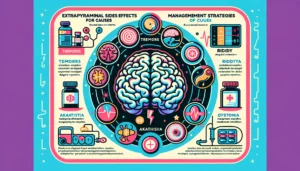Introduction
Psychiatric medications are a crucial part of treatment for many mental health conditions. However, they can also have various side effects, including extrapyramidal (EPS). EPS is a group of movement disorders that can be caused by medications that block dopamine receptors in the brain. They can cause various symptoms, including tremors, rigidity, akathisia, and dystonia.
EPS can be a significant challenge for both patients and providers. Patients may find the symptoms to be distressing and debilitating, and they may be reluctant to continue taking their medications. Providers need to be able to identify and manage EPS to provide optimal care for their patients.
This blog post will guide medical students in navigating extrapyramidal side effects. We will discuss the basics of EPS, including the symptoms, causes, and risk factors. We will also provide information on how to identify and manage EPS.

The Basics of EPS
Symptoms
EPS can cause a variety of symptoms, including:
- Tremors: Tremors are involuntary shaking movements that can affect any body part. They are the most common symptom of EPS.
- Rigidity: Rigidity is a feeling of stiffness in the muscles. It can make it challenging to move around.
- Akathisia: Akathisia is a feeling of restlessness and inner urgent to move. It can be very uncomfortable for patients.
- Dystonia: Dystonia is a condition that causes involuntary muscle contractions. It can cause twisting or contorting movements of the body.
Causes
EPS is caused by medications that block dopamine receptors in the brain. Dopamine is a neurotransmitter that is important for movement. When dopamine receptors are blocked, it can lead to an imbalance of neurotransmitters in the brain, which can cause EPS.
The most common medications that cause EPS are antipsychotics. Antipsychotics are a type of medication that is used to treat schizophrenia and other psychotic disorders. Other drugs that can cause EPS include metoclopramide (Reglan), a medication that is used to treat nausea and vomiting, and promethazine (Phenergan), a drug that is used to treat allergies and nausea.
Risk factors
There are several factors that can increase the risk of developing EPS, including:
- Age: EPS is more common in older adults.
- Dose of medication: The higher the dose of medication, the greater the risk of EPS.
- Length of treatment: The longer a person takes medication, the greater the risk of EPS.
- Underlying medical conditions: People with certain medical conditions, such as Parkinson’s, are at an increased risk of EPS.

Identifying EPS
It is essential to be able to identify EPS to provide optimal care for patients. There is no single test that can diagnose EPS, but several clinical signs and symptoms can suggest a diagnosis. These include:
- The presence of abnormal movements, such as tremors, rigidity, akathisia, or dystonia
- A history of taking medications that can cause EPS
- The absence of other conditions that could explain the symptoms
Consulting with a healthcare professional is essential if you suspect a patient may be experiencing EPS.

Managing EPS
Several strategies can be used to manage EPS. These include:
- Reducing the dose of medication: This is the most common strategy for managing EPS. If possible, the dose of medication should be reduced to the lowest effective dose.
- Switching to a different medication: Several drugs are less likely to cause EPS than others. If EPS is a significant problem, switching to a different medication may be necessary.
- Adding an anticholinergic medication: Anticholinergic medications can help to improve some of the symptoms of EPS. However, they can also cause side effects, such as dry mouth, constipation, and urinary retention.
- Deep brain stimulation (DBS): DBS is a surgical procedure that can be used to treat severe EPS. DBS involves implanting electrodes in the brain that stimulate the parts of the brain that are involved in movement.
Conclusion
EPS can be a significant challenge for both patients and providers. However, with careful monitoring and management, most patients can continue to take their medications and live entire and productive lives.
visit Our PMHNP Review Course 30- Day Walk to Succes – NP Exam Coach


